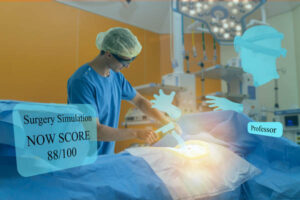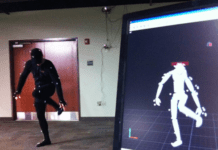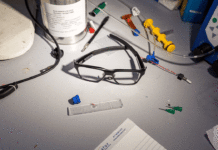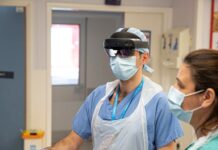
A recent study shows that an augmented reality surgical navigation (ARSN) system in a hybrid operation room can help to minimize occupational radiation exposure. The study was conducted by researchers at the Karolinska Hospital in Stockholm, Sweden, the Karolinska Institutet in Solna, Sweden, and Philips Healthcare in the Netherlands. It involved 20 patients who were scheduled for open spine surgery with pedicle screw placement. The procedures were performed in a hybrid OR and surgeons used the ceiling-mounted Philips Allura Clarity Flexmove robotic C-arm, with the aid of an integrated ARSN system.
Surgeons used the 2D fluoroscopy imaging to identify the spinal level and an intraoperative cone-beam computerized tomography (CBCT) image was acquired for navigation planning and screw placement. Another tomography was performed to correct the screw replacement before closing the wound instead of doing a postoperative CT. The staff radiation exposure was measured by using active personnel dosimeters in real-time. This was further compared with the results from a reference dosimeter attached to the C-arm. The estimation of the effective doses was measured by extracting radiation dose structured reports that showed the patient radiation exposure characteristics. This helped the surgeons obtain a more accurate reading than traditional methods.

According to the results, the average staff-to-reference dose ration per procedure was 0.05% and the figure decreased to less than 0.01% after procedures had been performed using the ARSN. The average patient ED matched with the number of vertebrae treated and the number of CBCTs performed. The last 10 procedures yielded a 32% ED reduction per spinal level treated and used a low-dose protocol. The researchers stated that by using real-time active personal dosimeters they could perform the task more efficiently. They could make use of more protective measures.
The study was published in Spine on January 1, 2020. The researchers involved used several types of research methods to arrive at their conclusions. Lead author of the study, Erik Edström, MD, Ph.D., of KI, stated that patient radiation dose was reduced by using a low-dose protocol with fewer x-ray pulses per second. A larger field of view, thereby improving the ratio between the number of imaged spinal levels and total dose. He further praised his colleagues along with the researchers. He said that,”the study showed that relatively low patient radiation levels can be achieved with the use of an ARSN system for spine surgery in a hybrid OR.”
The use of 3D imaging has increased dramatically especially the technology that is used for imaging obtained by a C-arm or a computed tomography system for intraoperative pedicle screw planning, placement, assessment, and revision. The risk of screw misplacement is significantly reduced when used in conjunction with an ARSN system. The technique might increase the risk of overall radiation exposure, but it does reduce occupational exposure. ARSN is radiation-free so staff can be safely positioned behind the protective shielding during imaging. This is just one way that new technology is improving the healthcare industry.























